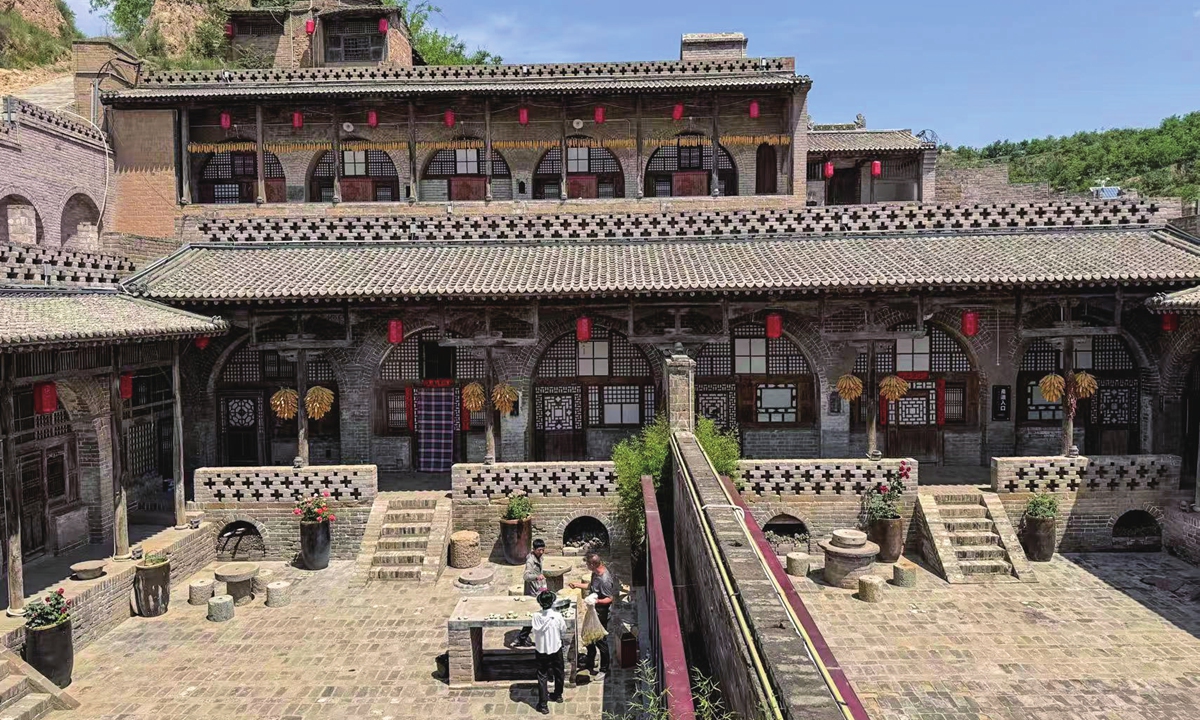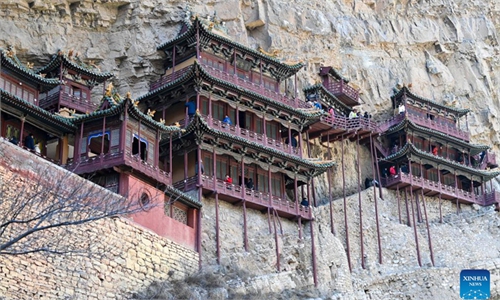ARTS / ART
Ancient architectural charm and modern country lifestyle in Lüliang revitalize cultural tourism

A courtyard-style residence in Zhangjiata Village in Fangshan County in Lüliang, Shanxi Province Photo: Li Yuche/GT
As the plane was about to land at Lüliang Dawu Airport, someone on board answered a phone call and said, "I've arrived" in the local dialect. Outside the window, the overlapping mountains and loess gullies silently remined travelers: they had arrived in Shanxi.Located in North China's Shanxi Province, Lüliang is one of the province's smaller cities, but it boasts a wealth of local heritage sites, including ancient architecture, wheat-centric culinary cultures as well as a rural lifestyle deeply rooted in history.
In Fenyang, a county-level city of Lüliang, lies a village called Jiajiazhuang. Once underdeveloped due to its barren saline-alkaline soil, this village has been transformed into a national AAAA scenic spot and it boasts three different types of rural industries. The key driver of the village's growth is its collective lifestyle, with all villagers actively contributing to local economic development and overall progress.
Rural rhythms
Jiajiazhuang Village is home to over 2,800 residents. Over the years, it has developed an agricultural industrial base, producing organic rice, hand-pulled noodles, vinegar, and other goods. Fenyang, where the village is located, is the birthplace of fenjiu, a type of Chinese liquor characterized by a unique light aroma. Leveraging the popularity of this product, the village now hosts bottle manufacturing and packaging enterprises.
"Our whole family lives and works in the village. Every day, we ride our scooters to work. We love this kind of unhurried lifestyle," Zhang, a villager, told the Global Times.
The Jiajiazhuang Village exhibition hall educates visitors about the local history. The transformative journey of the village is told through vivid displays: from gaining access to tap water in 1978 to establishing a film school in 2020, the walls of the exhibition halls show the remarkable evolution of the local community
Xing Wanli, the village's Party Secretary, told the Global Times that in recent years, the local endeavours to "develop cultural industries," have leveraged cultural and service-oriented projects as "the cornerstone for rural cultural tourism development."
One such cornerstone is the Open Village, a cultural space that integrates a cinema, a bookstore and a café. It was established with the support of Jia Zhangke a renowned arthouse film director born in Fenyang.
The site not only allows local villagers to watch trending films at the same time as urban cinemas, but also revitalizes the village's literary heritage.
Historically, notable cultural figures like Ma Feng, a literary giant of Chinese rural realism, considered this village the archetype for his literary creations.
In 2019, the first Lüliang Literature Festival was held in the Open Village, bringing Ma's legacy to the contemporary stage.
Xiaolu (Pseudonym), a 28-year-old designer from Taiyuan, told the Global Times that the cultural space in Jiajiazhuang village has become an "artistic and spiritual utopia" for many young people like her.
"Here, the cinema and the bookstores feature some most cutting-edge artistic offerings. Though this cultural space isn't located in a major city, it's precisely its unique connection to rural life that makes it so captivating," said Xiaolu.
"We have more cultural initiatives on the way, in September this year, our film school will officially open," Xing noted.

A bird's-eye view of the ancient town in the Qikou Scenic Area of Lin County, North China's Shanxi Province Photo: VCG
Ancient aestheticsBeyond Jiajiazhuang village's unique rural lifestyle, Lüliang's ancient architectural heritage continues to captivate visitors. Notably, the Taifu Guan - also known as the Taifu Taoist Temple - stands as a testament to centuries of history and spiritual significance.
Though its exact founding date remains unknown, records confirm the building's existence during the Jin Dynasty (1115-1234), granting it over eight centuries of history. The character "Tai" signifies the Supreme Ultimate, representing vitality and cosmic origin, while "Fu" denotes mandate, symbolizing the divine order governing natural laws.
The temple complex features exquisite architecture, elegant painted sculptures, suspended clay statuary, and intricate murals, rich in Taoist symbolism and remarkably well-preserved despite centuries of weathering. At the site, renowned Chinese architect Wang Shu explained that the architecture's dougong bracket structure reminds of the skeletal wing of a bird. Its upward-curving ends evoking imminent flight. "These bold, powerful brackets epitomize Liao (916-1125) Jin aesthetics, contrasting sharply with the increasingly ornate yet diminished brackets of later eras," said Wang.
At another touristic spot the Zhangjiata village in Lüliang's Fangshan County, it is characterized by its traditional courtyard-style layout, with 36 residential compounds. These architectural structures boast a history of over 350 years. Every brick and tile bears witness to the distinctive features, architectural styles and evolutionary journey of the local vernacular dwellings.
Lüliang's architectural aesthetics can also be enjoyed in the Qikou Ancient Town area. During the Ming (1368-1644) and Qing (1644-1911) dynasties, the town served as a vital transport station in Shanxi, distributing goods across the country.
Nowadays, well-preserved Ming and Qing structures including banking houses, pawnshops, temples, residences, and docks adorn the streets, showcase intricate brick carvings, woodwork, and stone sculptures. No visit to Qikou is complete without experiencing an immersive performance of A Dream in Qikou. Blending modern stagecraft with cultural heritage, the show traces millennia of local history and has gradually transformed the old town into a trending cultural touristic resource.
No journey is complete without tasting the region's iconic local dishes. Lüliang's iconic dishes of "Shou wowo" (hand-clasped potato dough) and "Wan Tuo" (bowl-set buckwheat jelly) showcase the local culinary ingenuity. The "Shou wowo" is made by shaping soft potato paste into thin wrappers by hand, while Wan Tuo is an example of rustic artistry. Buckwheat batter is steamed in coarse clay bowls until set, then inverted into delicate, disc-shaped servings. Served with aged vinegar and chili oil, the dish is a beloved street food that reflects the local's folk history. "Unlike the delicate cuisine in provinces like Zhejiang, Shanxi's dishes may appear rustic, but they embody the distinctive wisdom of ordinary people," said Zhou Ming, a Fenyang local.



